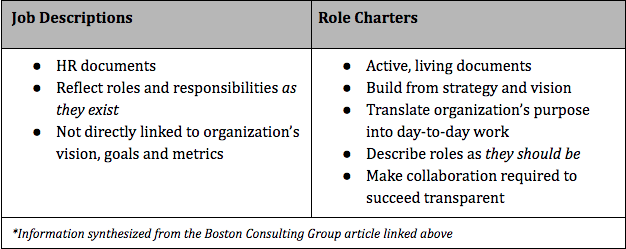4 Tips to Help Your Newly Hired Rockstar Become a Thriving Leader
Topics

Educators are the lead learners in schools. If they are to enable powerful, authentic, deep learning among their students, they need to live that kind of learning and professional culture themselves. When everyone is part of that experiential through-line, that’s when next generation learning thrives.
4 ways to foster the growth of our leadership team while avoiding some of the most common pitfalls.
Schools and districts devote much time to the interview process, seeking transformational leaders to join the team. But in the excitement of bringing in new talent, whether experienced educators from outside the organization or outstanding current teachers transitioning to school leadership positions, it’s critical to remember that great leaders are made, not hired.
At Thrive, a charter public school in San Diego, we have expanded from one to four campuses, constantly growing our leadership team. In the process, we have learned a few things about how to foster the growth of our leadership team while avoiding some of the most common pitfalls.
How do you make sure an ambitious, dynamic new leader isn’t stymied by ‘analysis paralysis’—so caught up in considering every decision that he never takes action? How do you keep the the ‘entrepreneurial leader’ from executing her vision so rapidly that she burns out her team and misaligns with the mission and vision of the organization, taking a school’s work in an unanticipated direction?
While we still have a lot more to learn as we grow, here are four practices that will help you develop your team, rethink onboarding, and enable both experienced and new school leaders to lead together, in the same direction, toward excellent results.
1. Spend more time than you think you should explaining your organization’s mission and vision.
A shared sense of purpose is the fuel that keeps people going when things get hard. Experienced leaders understand this, but newer leaders may get caught up in the ‘how’ at the expense of the ‘why.’ New leaders need to understand what drives your organizational culture, so give them context. Tell them stories about students, give examples of the impact of the work, and ask them to share their hopes and dreams of how their work will make a difference. Take every opportunity to do this—over coffee, during dinner, or while on break from other work.
School Director Shelli Kurth remembers in her earliest days as a Thrive leader that “Thrive always made sure I felt like I was part of the vision work. The work always felt meaningful and authentic.” This doesn’t happen by chance. Making work meaningful is an intentional process of curating stories and sharing them often. Crafting this clear and compelling vision ensures that when a new leader doesn’t know how to do something, she at least knows clearly where she is headed.
At Thrive, we often use this analogy: If I throw a party and everyone knows exactly where that party is, it doesn’t matter if they walk, take public transportation, carpool, or ride in a taxi. We all end up at the same place. But if I only give directions (walk three blocks, turn right, and then take the #23 bus), a number of things could derail the party guests. Leaders must trust that once they have clarified a destination, a competent team can arrive there using their own creativity and good judgment.
2. Once you’ve clarified your vision, do the same for leadership roles—including autonomy.
Most supervisors tell their staff which rules they need to follow, but not the level of autonomy they’re allowed within the system. Early in my career, my executive coach taught me about role charters. While a job description is merely a static HR document, with a direct link to a school’s visions, goals, and metrics, a role charter is a living document that helps folks see connections between themselves and others. (Check out what the Boston Consulting Group says about role charters, and then consider spending a few hours to create role charters for your team.)

Once team members see their interconnectedness, it is easier to understand where they need to collaborate with peers, where constraints exist, and what opportunities exist for creativity. A balance of structure and autonomy allows new leaders to thrive.
“My mentors always had an open door and big hearts to support me when I needed it most,” says Dean Jaclyn Vasko. “This culture of love and trust allowed space for me to share and develop my goals with my leaders. Since joining the leadership team, I’m supported with a mentor, and the door is still open for feedback and forward thinking. Every day is new, and a learning moment, but I’m never alone in my practice.”
3. Support your new leader in building a network.
Whether a leader is new to a city or just to their role, finding folks to turn to for information and help is critical. A well-connected leader will find inspiration in school visits, seek advice from peers, and turn to trusted parents as advisors and sounding boards. This network will make sure your leader succeeds. No matter how much support a new leader receives from their direct supervisor, there’s no substitute for meeting the local community center director, members of the clergy, the principal of a great school across town, and other community anchors. They will immeasurably enhance the impact of your new leader, ensuring that he or she has a wealth of perspectives and insights to lean on.
“My greatest learning and growth has come from the leaders that exist within our community,” says Thrive Intervention Coordinator Courtney Ochi. “Working with other great leaders challenges me to take on responsibilities that help me deepen my understanding of Thrive and the ways that we are impacting our community.”
4. Make sure your new leader creates a 90-day plan.
Many new leaders will try to jump into the work and get frustrated that they do not immediately see the change they want. I recommend that they read The First 90 Days to understand the hidden work required at the start of a new position, engage in intentional listening tours, and share their own 90-day plan with a supervisor so that any goals are in alignment with the organization’s vision. In monthly check-ins with the 90-day plan as a guide, a new leader and their supervisor can recognize changes, challenges and opportunities early on, allowing them to reinforce what works while adjusting what doesn’t.
Finally, as you grow your leadership team, make sure to enjoy the process! People have the potential for greatness. Give a new leader enough time, information and support, and you will see them tackle challenges with solutions and innovations you never imagined.




